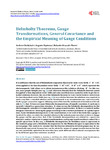
Please use this identifier to cite or link to this item:
http://ricaxcan.uaz.edu.mx/jspui/handle/20.500.11845/538| Title: | Helmholtz Theorems, Gauge Transformations, General Covariance and the Empirical Meaning of Gauge Conditions |
| Authors: | Chubykalo, Andrew Espinoza, Augusto Alvarado Flores, Rolando |
| Issue Date: | May-2016 |
| Publisher: | Scientific Research Publishing |
| Abstract: | It is well known that the use of Helmholtz decomposition theorem for static vector fields C : R3 → R3 , when applied to the time dependent vector fields E : R4 → R3 , B : R4 → R3 which represent the electromagnetic field, allows us to obtain instantaneous-like solutions all along R3 . For this reason, some people thought (see e.g. [1] and references therein) that the Helmholtz theorem cannot be applied to time dependent vector fields and some modification is wanted in order to get the retarded solutions. However, the use of the Helmholtz theorem for static vector fields is correct even for time dependent vector fields (see, e.g. [2]), so a relation between the solutions was required, in such a way that a retarded solution can be transformed in an instantaneous one, and conversely. On this paper we want to suggest, following most of the time the mathematical formalism of Woodside in [3], that: 1) there are many Helmholtz decompositions, all equally consistent, 2) each one is naturally related to a space-time structure, 3) when we use the Helmholtz decomposition for the electromagnetic potentials it is equivalent to a gauge transformation, 4) there is a natural methodological criterion for choosing the gauge according to the structure postulated for a global spacetime, 5) the Helmholtz decomposition is the manifestation at the level of the fields that a gauge is involved. So, when we relate the retarded solution to the instantaneous one what we do is to change the gauge and the space-time. And, if the Helmholtz decompositions are related to a space-time structure, and are equivalent to gauge transformations, each gauge transformation is natural for a specific space-time. In this way, a Helmholtz decomposition for Euclidean space is equivalent to the Coulomb gauge and a Helmholtz decomposition for the Minkowski space is equivalent to the Lorenz gauge. This leads us to consider that the theories defined by different gauges may be mathematically equivalent, because they can be related by means of a gauge transformation, but they are not empirically equivalent, because they have quite different observational consequences due to the different space-time structure involved. |
| URI: | http://hdl.handle.net/20.500.11845/538 https://doi.org/10.48779/mdqz-sk52 |
| ISSN: | 2153-1196 2153-120X |
| Other Identifiers: | info:eu-repo/semantics/publishedVersion |
| Appears in Collections: | *Documentos Académicos*-- UA Física |
Files in This Item:
| File | Description | Size | Format | |
|---|---|---|---|---|
| 2016 Journal of Modern Physics, 7, 1021-1044.pdf | 499,04 kB | Adobe PDF |  View/Open |
This item is licensed under a Creative Commons License
